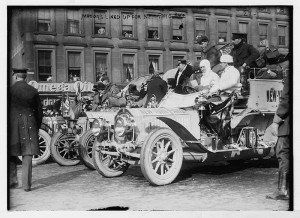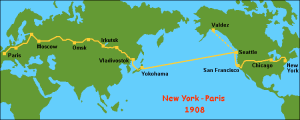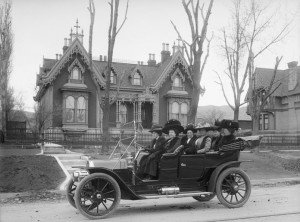Taking a look back at what was perhaps the most daring feat in the early 1900’s, the Automobile Race Around the World and the amazing Thomas Flyer, is a very unique trip into history. The Great Race took place at the very start of the automobile industry. Automobile companies were a novelty. The horse was considered by many to be the mode of transportation of choice. This was a time of course before adequate roads were built even in the United States let alone foreign countries, especially Asia and the Middle East, and it was thought by many at the time to be quite a foolhardy and obviously dangerous endeavor. It would be another twenty years before Route 66 came into being. The Great Race however would go on.
 In February 1908, six competing cars were lined up in New York City (photo at left) to attempt a race from New York to Paris France for what was billed the “around the world car race”. The six automobiles that entered this race represented four different nations. This race was directly a result of an earlier competition in 1907 which saw an auto race from Peking China to Paris France. The 1907 race inspired daredevils to attempt something larger and more challenging, although a car race from China to France itself seems quite challenging in itself. In case you’re wondering how the idea came about for a China to France race, a Paris newspaper printed an editorial in 1907 suggesting that when the technology (automobile) is available to man, he should press it to it’s limits. In this editorial they pointedly suggested a Peking to Paris race. Apparently the newspaper had a bit of influence and several early car enthusiasts jumped at it.
In February 1908, six competing cars were lined up in New York City (photo at left) to attempt a race from New York to Paris France for what was billed the “around the world car race”. The six automobiles that entered this race represented four different nations. This race was directly a result of an earlier competition in 1907 which saw an auto race from Peking China to Paris France. The 1907 race inspired daredevils to attempt something larger and more challenging, although a car race from China to France itself seems quite challenging in itself. In case you’re wondering how the idea came about for a China to France race, a Paris newspaper printed an editorial in 1907 suggesting that when the technology (automobile) is available to man, he should press it to it’s limits. In this editorial they pointedly suggested a Peking to Paris race. Apparently the newspaper had a bit of influence and several early car enthusiasts jumped at it.
The Great Race from New York to Paris was sponsored by both the New York Times and the La Matin, the Paris paper which encouraged the 1907 race from China to France. To give you an idea of the scope of this race, the route taken went from New York City through Chicago, San Francisco, Seattle, Valdez Alaska, then via boat to Japan and Vladivostok Russia and then across Asia and through Berlin to Paris. The original intent was to cross into Asia via the Berings Strait off Nome Alaska but it wasn’t possible at the time. Remember, this was before any suitable network of service stations and repair shops were in existence. In a real way, the dangers were somewhat similar to those of the pioneers in the 1800’s on the Oregon Trail minus Indian attacks. Nations represented with automobiles in this race included the United States, Italy, Germany and France.
 There was a lot riding on this race. The Great race along with the successful race from Peking to Paris in 1907, could settle the question of the reliability of automobiles. Let’s remember, there were many who were still using the horse and buggy. In 1908, there were many who considered the horse more reliable than the automobile. For automobile sales to take off and be widely accepted by the public, their reliability had to be proven. These races, in effect, did just that although I’m not sure many customers were purchasing a car with the intention of driving around the world.
There was a lot riding on this race. The Great race along with the successful race from Peking to Paris in 1907, could settle the question of the reliability of automobiles. Let’s remember, there were many who were still using the horse and buggy. In 1908, there were many who considered the horse more reliable than the automobile. For automobile sales to take off and be widely accepted by the public, their reliability had to be proven. These races, in effect, did just that although I’m not sure many customers were purchasing a car with the intention of driving around the world.
The race began on February 12, 1908 from Times Square in New York City. A quarter of a million people gathered to see the race begin.The American entry, the Thomas Flyer, after driving through Albany and then westward through Chicago, was the first to reach San Francisco in a bit over 41 days. Not bad at all when you consider that the 1800’s wagon trains from Missouri to California took six months to arrive there. This race in 1908 ended up covering some 22,000 miles and took 169 days to reach Paris. Only three of the six cars were able to reach Paris. When you think about it, three cars out of six being able to finish this type of auto race in the year 1908 sounds pretty amazing. When the public realized how an automobile could perform under these circumstances and over those distances, they would look at the car entirely different. No longer just an amusement, the automobile became a valuable new means of transportation and the Great Race demonstrated it.
You may also enjoy reading our Trips Into History article about Alberto Santos-Dumont and the Invention of the Airplane
In the end, the Thomas Flyer entry from the United States won the Great Race, driven by George Schuster. As it turned out, the German car actually entered Paris four days before the Thomas Flyer. Although at first the Germans were awarded first place, it was later learned that the German driver took a series of shortcuts off the official route, and the Thomas Flyer was moved up to first place.
 The Thomas Flyer race car was a Model 35. The Thomas Flyer had four cylinders, a 60 horsepower engine and could hit a speed of 60 MPH. That was quite fast in 1908. The photo at left is a 1909 Thomas Flyer. During the first decade of the 1900’s, there were several automobile companies. Some of these also made bicycles and just added automobiles to their product line. The car was manufactured by the E.R. Thomas Motor Company in Buffalo New York. It was a pricey automobile costing about $4,000 in 1908. The Thomas Motor Company also produced motorized bicycles one of which traveled across the U.S. in 1905 at a record time of 48 days.
The Thomas Flyer race car was a Model 35. The Thomas Flyer had four cylinders, a 60 horsepower engine and could hit a speed of 60 MPH. That was quite fast in 1908. The photo at left is a 1909 Thomas Flyer. During the first decade of the 1900’s, there were several automobile companies. Some of these also made bicycles and just added automobiles to their product line. The car was manufactured by the E.R. Thomas Motor Company in Buffalo New York. It was a pricey automobile costing about $4,000 in 1908. The Thomas Motor Company also produced motorized bicycles one of which traveled across the U.S. in 1905 at a record time of 48 days.
The Thomas Flyer was eventually purchased by William F. Harrah who restored the car to the exact way it looked when entering Paris in 1908. Today, the original Thomas Flyer which won the Great Around the World Auto Race, is on exhibit at the National Automobile Museum in Reno Nevada along with the Harrah auto collection.
It’s interesting to note that most car enthusiasts believe that today’s cross country marathon auto race events all go back to the great race of 1908 for their inspiration. There are competitions for vintage cars and classic cars scheduled throughout the country. Also muscle cars, sports cars and trucks have their own events. The Great Race of 1908 set the tone.
Many people might still remember the 1965 movie, The Great Race, starring Tony Curtiss along with Peter Falk as his sidekick. Tony Curtiss plays “The Great Leslie”. He of course is dressed in white and the villain (competing racer) is dressed in black. This slapstick comedy movie was based on the 1908 event with the storyline being a New York to Paris race. In this particular Hollywood made race, Peter Falk sabotage’s three other cars and his own by mistake. The film unfortunately was not a smash hit and many events of course were pure fiction, but nevertheless, it does take you back to the daring days of great invention and around the world auto racing.
(Photos are in public domain).
